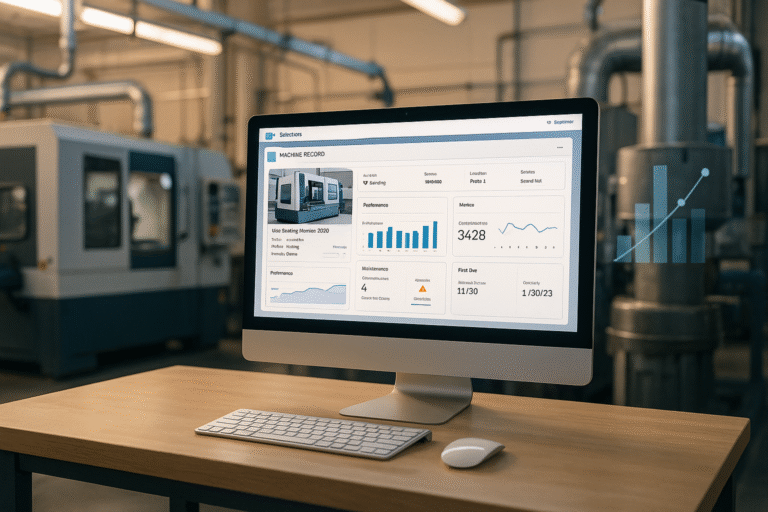Avoid unplanned machine downtime with asset management
The pressure on manufacturers in the mechanical and plant engineering sector is constantly growing. This is because unplanned machine downtimes not only drive up the costs of repair measures for machine operators. In addition to the reduced productivity of the respective operation, there are often delivery delays. These can quickly lead to critical consequences for the entire value creation network. In order to minimize this risk, it is therefore necessary to be able to rely on the availability of the systems. Consequently, in no other sector is this as essential as in the process industry with its highly networked production facilities. However, the stable operation of machines and vehicles is also crucial for those responsible for complex processes in assembly or logistics.
Less hassle thanks to asset management
For the customers of machine and system manufacturers, the productivity of their systems determines their business success. They are therefore looking for suppliers who can provide comprehensive solutions for their needs.
The requirements go far beyond the delivery of a flawless product. With efficient services, machine manufacturers assume long-term responsibility for their machines and systems. As a result, they relieve customers of part of their operating risk. An indispensable basis for this is knowing which machines are in use at the customer’s premises and using the information productively.
"An indispensable basis for efficient service in mechanical engineering: knowing which machines are in use at the customer and the productive use of machine data."
How asset management supports your business
Manufacturers of investment-intensive goods are increasingly measured by their service. As part of long-term service contracts or operator models, they therefore ensure the long-term performance of their products. This also offers manufacturers (OEMs) opportunities: instead of selectively, as with the sale of new machines, they generate continuous revenue over the entire life cycle of the system.
Industrial asset management helps operators and OEMs alike to maintain an overview of the installed base. It also provides real-time information that forms the starting point for increasing the reliability and performance of the systems. The technical basis is the Industrial Internet of Things (IIoT). This allows people as well as virtual and physical objects to communicate with each other in real time.
The information can be used for many applications:
Management of the installed base: In the first step, asset management software brings together information about the relevant fixed assets. It makes this information globally available to operators, service technicians and planners at any time.
Status monitoring: Current status data provides early warning of impending faults or maintenance measures that are due. By reacting quickly, automatically notified technicians can avoid or at least significantly shorten system downtimes.
Decision support: Dashboards show the current performance parameters of the system and provide information on measures for optimization.
Digital knowledge management: Assign the know-how of experienced experts from production and maintenance to your machines in the asset management platform. This makes it available online for training new employees. Storage in a central location protects against the loss of manuals, videos or other documents.
Improved customer service: Linking to your CRM system gives you a consistent view of customers and their products. This enables an even more individualized customer relationship.
Focus on operational maintenance: Maintenance engineers and production planners use the sensor-based data recorded in the asset management system for remote condition monitoring. For example, they can use recorded temperatures or vibrations to determine whether the device is operating within the target range. Based on this, they start the root cause analysis and initiate suitable measures. At the same time, the asset management system becomes a knowledge platform as soon as maintenance or repair activities are required. This eliminates waiting times and also enables the parallelization of activities such as troubleshooting or spare parts procurement.
Optimize maintenance strategies
If appropriate tools are available for analysis, asset management helps to optimize the maintenance strategy. This means that the combination of preventive maintenance with real-time data offers great potential for increasing overall equipment effectiveness (OEE). Consequently, this concept of condition-based maintenance effectively reduces the costs associated with service costs, production downtime or unstable product quality. However, analyzing real-time information also makes it possible to look into the future. Predictive methods (predictive maintenance) go even further by predicting the optimum time for maintenance. In this way, they ensure that maintenance activities can be planned even better.
Taking service to the next level with asset management
More and more OEM decision-makers from After Sales and Business Development are recognizing the new possibilities of asset management platforms. Consequently, their focus is primarily on the possibility of collecting information about customer-owned assets. However, the key prerequisite for this is linking the asset data with the customer knowledge recorded in the CRM system.
In the event of a service call, the information can be used to derive sensible technical measures and customized communication. Knowledge of the repair history is not only an important aid for technical support when interacting with the customer. For example, potentially dissatisfied customers with a large number of complaints receive assistance on how to use the product that is tailored to their needs.
Asset management for transparency across your installed base becomes a necessity
Decision-makers should act decisively when introducing asset management in order to secure a competitive advantage for their organization. Because, as with the digital transformation of entire business models, the following applies: while the avant-garde extends its lead, asset management becomes a mere necessity for late adopters.
Would you like to know more about industrial or IoT asset management and the possible applications? Our white paper“Your installed base in focus” provides an overview.




